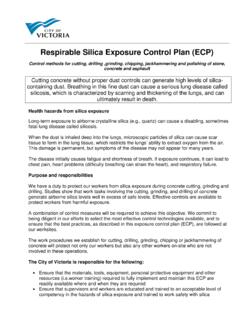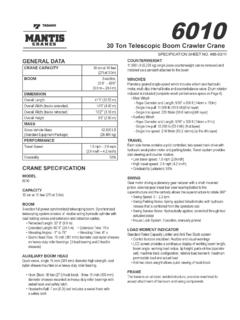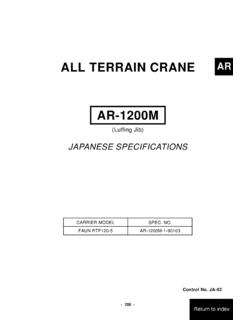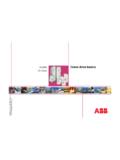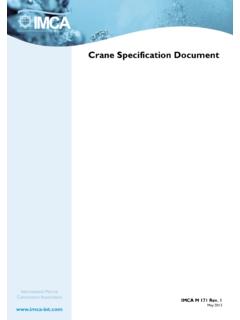Transcription of Review of Some Common Boom Truck and Bucket …
1 Review of Some Common boom Truck and Bucket Truck OH&S regulations 1. crane Operator Certification (OH&S ) Mobile cranes, tower cranes and boom trucks (telescoping, articulating, knuckle, stiff boom , etc) that have a rated capacity of 5 tons or greater, or a boom length of 25' or more must be operated only by a person with a valid operator's certificate issued by a person acceptable to the Board, and in accordance with any conditions stipulated on the certificate. This regulation does not apply to vehicle mounted aerial devices ( Bucket trucks) at this time. Bucket trucks are not considered cranes or boom trucks. The following link gives guidance for the operator certification requirement: # If operator certification is required the registration process is through the BC Association for crane Safety (BCACS).
2 Here is the link to the BCACS website: Once the operator is registered they will be contacted by BCACS with a registration confirmation letter. The operator must then contact the Fulford Harbor Group (FHG) and request an assessment date. Until the operator has successfully completed the assessment he/she should maintain a copy of either the BCACS or FHG registration/assessment notification letter as proof they have registered and are awaiting assessment. With regards to operator training on Bucket trucks although there isn t a requirement for the crane operator certification process, the following information is from the CSA Standard C225-00 which covers this type of equipment and is enforced by WorkSafeBC: General Training Only personnel who have received general instructions regarding the inspection, application, and operation of aerial devices, including recognition and avoidance of hazards associated with their operation, shall operate an aerial device.
3 The items covered in their training shall include, but not necessarily be limited to, the following: (a) the purpose and use of manuals; (b) the requirement that operating manuals, as an integral part of the aerial device, shall be properly stored on the vehicle when not in use; (c) prestart inspection; (d) responsibilities associated with problems or malfunctions affecting the operation of the aerial device; (e) factors affecting stability; (f) the purpose of placards and decals; (g) workplace inspection; (h) safety rules and regulations ; (i) authorization to operate; (j) operator warnings and instructions; and (k) actual operation of the aerial device: under the direction of a qualified person, the trainee shall operate the aerial device for a sufficient period of time to demonstrate proficiency in the actual operation of the aerial device.
4 2. Stability Test (OH&S ) Cranes mounted on carriers are either designed and supplied by a crane manufacturer as a unit (integral unit), or the crane is mounted on a carrier provided by an end user (combination unit). Integral Units - The manufacturer of integral units will perform a practical stability test as described by the crane Load Stability Test Code - SAE J765 (SAE J765), published in the SAE Handbook, to ensure the crane will remain stable when used in accordance with the supplied load chart. For an integral unit with a suitable manufacturer-supplied load chart, it is not necessary for a new or updated load chart to be produced, or for stability testing to be re-done, until and unless one of the following conditions occurs.
5 : (a) the manufacturer's specification or other acceptable warranty cannot be produced, (b) the equipment or machine has been modified in a manner which will change its rated capacity or rated load, (c) wear, corrosion, damage or signs of fatigue are found which may reduce the rated capacity or rated load, (d) the equipment or machine is used in a manner or for a purpose other than that for which it was originally designed, if the use will change the safe working load, or (e) in the opinion of the Board, the provision of such certification is deemed necessary. Combination Units - Where the crane and carrier units have been discretely designed and manufactured.
6 They can only be tested for stability after the crane has been mounted to the carrier. The tests performed must be unit tests; that is, each boom and carrier set is tested for stability. The load chart for the combined crane and carrier needs to show the capacity that is the lower of that determined from the stability testing and the capacity that was provided by the boom manufacturer. The load chart needs to show the capacity relative to the portion of the swing circle to which it applies in a work area diagram. For example, the load chart may be applicable for 360 of swing or there may be a reduction in some portions of the swing circle compared to others.
7 In some cases, there may be zero capacity in some portions of the swing circle. The ability of the carrier frame and attachment to safely support the loads shown in the load chart(s) is also to be verified by a professional engineer for each combination unit. This verification of structural competence for the hoist capacity is required in addition to the stability test. ** While the description above is for boom trucks, the same regulation is applicable to Bucket trucks. Both boom trucks and Bucket trucks require a stability test and 360 degree load chart. The difference is boom Truck stability tests are as described in SAE J765 as noted above, and Bucket Truck stability testing is as described in the CSA Standard C225-00.
8 The following link provides more detailed guidance for stability testing: # 3. Annual Inspection/Certification (OH&S boom Trucks, 13. 23 Bucket Trucks) Both boom trucks and Bucket trucks must be inspected at least once every 12 months, by a professional engineer, in accordance with good engineering practice, and certified in writing as safe for use. The unit must not be used after the inspection unless a professional engineer certifies it is safe for use on the basis of that inspection. 4. Manufacturer's Manual (OH&S boom Trucks, Bucket Trucks) The portions of the manufacturer's manual related to the assembly, erection, dismantling, inspection, routine maintenance and safe operation of the crane or Bucket unit must be available at the workplace where the boom Truck or Bucket Truck is being used, or if the manual is not available a professional engineer's written instructions for this information would be required.
9 5. Pre-Use Inspections (OH&S boom Trucks, Bucket Trucks) A boom Truck and Bucket Truck must be inspected before use on each shift and after any modification, and any condition that might endanger workers must be remedied before the equipment is used. The inspection and testing must be carried out in the manner specified by the manufacturer, and the applicable safety standard. Records of the inspection must be maintained with the unit. 6. Outrigger Setup (OH&S ) Blocking, shoring or cribbing must be sized and used as necessary to ensure the load from a mobile crane or boom Truck support does not exceed the bearing capacity of the supporting surface.
10 ** IMPORTANT ** The information in this document is provided to assist employers and operators with interpretation and understanding of only some of the regulations specific to boom trucks and Bucket trucks. There are many other regulations specific to this type of equipment that is not covered in this document. Some of the regulation topics not covered in this document include, but are not limited to: - Working near high voltage and induced voltage - Critical lift procedures - Anti-2-Blocking - Load Cells - Traffic Control - Working near excavations, concrete slab re: engineering requirements - Overlapping cranes - Radio contact Refer to the OH&S regulations Parts 13 and 14 for complete regulatory requirements for boom trucks, Bucket trucks and man-lifts.


